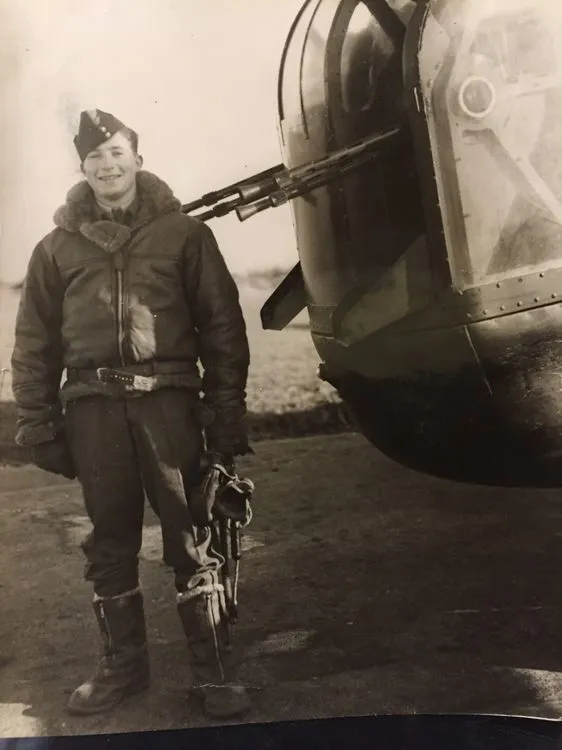McCaw, John Francis James (Flight Sergeant)
Killed in Action 1943-March-29


Birth Date: 1923-February-23
Born: Bancroft, Hastings County, Ontario, Canada
Parents: Son of Harry Wallace McCaw & Marjorie Alice (nee Fairfield) McCaw of Belleville, Ontario
Spouse:
Home: Belleville, Ontario
Enlistment:
Enlistment Date: unkown date
Service
RCAF
Unit
218 (B) Sqn- Squadron (RAF)
In Time
Base
RAF Downham Market
Rank
Flight Sergeant
Position
Air Gunner (Rear)
Service Numbers
R/105188
Crew or Other Personnel
Stirling BK716
Mission
Stirling Mk. lll BK716
Bombing Berlin Germany 1943-March-29 to 1943-March-29
218 (B) Sqn (RAF) RAF Downham Market
218 Gold Coast Squadron (In Time), RAF Downham Market. Stirling Mk III aircraft BK 716 HA-J was shot down by night fighter crew of Leutnant Werner Rapp and Unteroffizier Hans Ortmann of 7/NJG1 during on an operation against targets in Berlin Germany. The bomber crashed into Lake IJsselmeer near Marken, Noord-Holland, Netherlands
Flying Officer Harry Gregory Farrington (RCAF), Flight Sergeant John Francis James McCaw (RCAF), Sergeant Charles Armstrong Bell (RAFVR), Flying Officer John Michael Campbell (RAFVR), Flying Officer John Frederick Harris (RAFVR) and Sergeant Leonard Richard James Shrubsall (RAFVR) were all missing, presumed killed in action. No crew remains were originally recovered and they were all commemorated on the Runnymede Memorial. However, in 2008 the wreckage of an aircraft was found. A cigarette case belonging to Flying Officer Campbell helped identify the aircraft to be identified but it was not until August 2020, that the remains of the seven crewmembers and their aircraft could begin to be recovered. After multiple problems and delays, the crew were finally buried with a full military service September 28, 2022 at the Commonwealth War Graves Commission Jonkerbos War Cemetery in Nijmegen, Gelderland, Netherlands
Nachtjagd Combat Archives 1943 Part 1, 1 January - 22 June by Theo Boiten, page 52
The Night of the Stirling by Evert van Ginkel
From St Vith to Victory, 218 (Gold Coast) Squadron and the Campaign Against Nazi Germany by Stephen C Smith, pages 142,291, 296-315
![]() Flying Officer Farrington and Flight Sergeant McCaw
Flying Officer Farrington and Flight Sergeant McCaw
![]() Stirling BK716 crew finally laid to rest I RAF Memorial Flight Club
Stirling BK716 crew finally laid to rest I RAF Memorial Flight Club
![]() Royal Air Force Serial and Image Database
Royal Air Force Serial and Image Database
![]() 29/30 03 1943 218 (Gold Coast) Squadron Stirling III BK716 HA J Fg...
29/30 03 1943 218 (Gold Coast) Squadron Stirling III BK716 HA J Fg...
Stirling serial: BK716

In June 1944, this Short S.29 Stirling B Mk. IV (Serial No. LK589), coded V3, RAF, was flown across the Atlantic as part of a navigation training exercise and did a tour of bases in Eastern Canada. It is shown here at Malton, Ontario. It was flown back to the UK after a two-week visit.
The Short Stirling was a British four-engined heavy bomber of the Second World War. It has the distinction of being the first four-engined bomber to be introduced into service with the Royal Air Force (RAF).
The Stirling was designed during the late 1930s by Short Brothers to conform with the requirements laid out in Air Ministry Specification B.12/36. Prior to this, the RAF had been primarily interested in developing increasingly capable twin-engined bombers but had been persuaded to investigate a prospective four-engined bomber as a result of promising foreign developments in the field. Out of the submissions made to the specification Supermarine proposed the Type 317, which was viewed as the favourite, whereas Short's submission, named the S.29, was selected as an alternative. When the preferred Type 317 had to be abandoned, the S.29, which later received the name Stirling, proceeded to production. In early 1941 the Stirling entered squadron service. During its use as a bomber pilots praised the type for its ability to out-turn enemy night fighters and its favourable handling characteristics whereas the altitude ceiling was often a subject of criticism. The Stirling had a relatively brief operational career as a bomber before being relegated to second line duties from late 1943. This was due to the increasing availability of the more capable Handley Page Halifax and Avro Lancaster, which took over the strategic bombing of Germany. Decisions by the Air Ministry on certain performance requirements (most significantly to restrict the wingspan of the aircraft to 100 feet) had played a role in limiting the Stirling's performance; the 100ft limit also affected earlier models of the Halifax (MkI & MkII) though the Lancaster never adhered to it.
During its later service, the Stirling was used for mining German ports; new and converted aircraft also flew as glider tugs and supply aircraft during the Allied invasion of Europe during 1944"“1945. In the aftermath of the Second World War, the type was rapidly withdrawn from RAF service, having been replaced in the transport role by the Avro York, a derivative of the Lancaster that had previously displaced it from the bomber role. A handful of ex-military Stirlings were rebuilt for the civil market. Wikipedia






